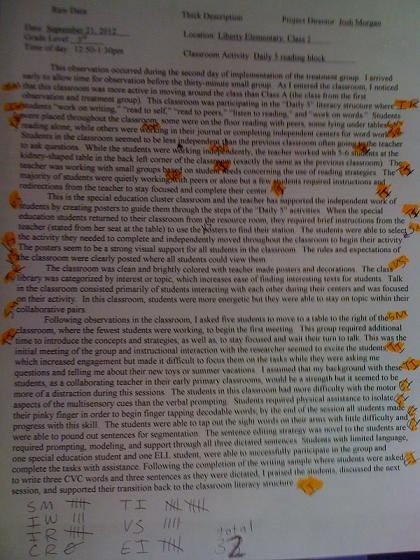Location: Third Grade Class A.
Time of day: 12:50-1:30pm Classroom Activity: Daily 5 reading
block
As I walked into the third grade
classroom, I instantly noticed that the students were working independently all
around the classroom. Some students were
typing words on an old, grey keyboard from an out-of-date desktop
computer. There was a group of students
working with laptop computers; they were participating in the “Listen to
Reading” component of the “Daily 5” classroom reading structure. From previous experiences in the school, I am
aware that these laptops were purchased for ELL students to use in the
classroom; I was glad to see that the use of this technology is not restricted
solely to the ELL students, but is used to support all students’ learning. Some
students were writing in their journals during the “Work on Writing” component
of the reading block; each of these students had stapled a small sheet of paper
in their journal with their writing prompts.
The writing prompts connected to both their writing block and their
vocabulary and literacy program, “Literacy by Design.”
In the back, left corner of the
classroom, five students were working at the kidney-shaped table with the
teacher. This group focused on
strategies from the “CAFÉ” reading strategy which has been adopted school wide
along with the “Daily 5.” When the
teacher finished with the group, she asked another group (named by their color
and supported with a poster on the wall with all of the names of students in
the group). The students who left the group moved to the front of the room and
moved their clothes pin, labeled by their name, from “work with the teacher” to
one of the other five options for literacy centers.
The students seemed to be very
familiar with the routine and were independent throughout the classroom. The teacher must have a firm grasp of
training routines at the beginning of the school year. The students were able to go to the restroom
without asking by writing their names on a plastic plate attached to the wall
(pink for girls, blue for boys). The tables,
for two students each, were in the center of the room and were arranged in a
horseshoe shape with the opening at the front of the classroom; there were additional
tables in the center of the horseshoe shape with openings in the back for
students to move around easily. The
classroom was clean and brightly colored with many supportive visuals on the
wall throughout the classroom including: math, reading, and science word walls,
posters to support the routine, “Daily 5” center details, etc. The classroom is equipped with a projector,
sink, whiteboard, document camera, laptops, and three student computers.
Talk in the classroom consistent of
students discussing books, asking for help with centers, collaborating with a
buddy to read a text, discussing events from their favorite television show,
and making connections from text to their lives. Students are prompted to request assistance
from peers before asking the teacher in order to build collaboration and
independence.
Following the observation of the
classroom, I asked five students to come to the front table, away from the
majority of distractions and peers, to begin our first instructional treatment
group. Once I announced the names of
students, several peers asked to participate in the small group
instruction. The students in the group
were excited about participating in the group and needed prompts to wait their
turn before speaking. This being the
initial meeting, the students were very curious about the activities we would
be completing and wanted to tell me all about themselves. Students in this group were adequately
focused even though there were a number of distractions around the room; I
actually started to think our group may be distraction other students due to
the novelty of the research in the classroom.
The students required additional prompts to understand the multisensory
strategies: finger tapping to segment CVC words, arm tapping to spell sight
words, pounding table to segment sentences.
These more physical tasks were confusing for some of the students but by
the end of each of the three activities they were showing progress. The students were strong with the sentence
editing strategy and after guided practice of the first two sentences; they
were able to complete the third with few prompts. Writing samples collected from this
observation were from the treatment group and consisted of writing CVC words,
sight words, and sentences using the multisensory method and the editing
strategy.

















